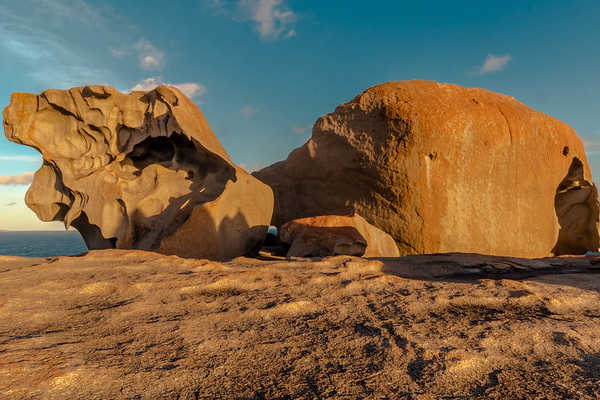Remarkable Rocks, Kangaroo Island
Kangaroo Island is a haven of lush scenery, unusual animal species, and weird rock formations – Remarkable Rocks being one of them. As one of the island’s best-loved landmarks, Remarkable Rocks proves to be a popular hit with visitor’s time and time again.
But what makes them so special? The rocks themselves have been intricately carved by the sea and wind over 500 million years. Around that time, Kangaroo Island formed a part of Godwana, a continent made up of Australia, South America, Africa, India, and Antarctica. 150 million years ago, this huge supercontinent began to split up, with Australia and Kangaroo Island moving northward and taking the Ordovician granite with it.
Common weathering minerals including feldspar and mica have seen the rocks shaped into the unusual silhouettes they showcase today.
The rocks themselves are perched 200 feet above the sea in the beautiful Flinders Chase National park, which sprawls out to the west of Kangaroo Island. They are a collection of gigantic, eroded granite boulders that, along with the bright orange lichen, offer ideal photo opportunities for visitors. You can even see the rocks on the satellite view on Google Maps because they’re so big.
Getting to Remarkable Rocks
First of all, you have to get a ferry from Cape Jervis to Kangaroo Island. You’ll arrive in Penneshaw, a little town to the east of the island. To get to the relatively untouched and wild west of the island, where the Remarkable Rocks are located, you’ll have to travel for around 100 kilometres. Alternatively, you can fly to Kangaroo Island from Australia’s mainland, but you’ll still have to travel from the east coast to the west coast into Flinders Chase National Park.
The Best Time to Visit Remarkable Rocks
Remarkable Rocks are impressive at any time of day thanks to their sheer size and unusual formation, but they are best appreciated early in the morning or in the evening. This means you can avoid the larger crowds that gather in the area during the middle of the day, but you can also experience the rocks when they’re at their most magical. The golden lichen that covers the rocks makes the sunrises and sunsets here pretty spectacular, where the formations turn a vibrant gold in the low light.
Interpretation signs surrounding the rocks give you the chance to learn more about their history and how they came to be – a fascinating prospect at any time of day.




